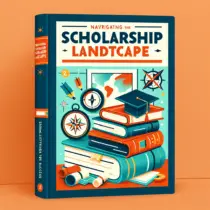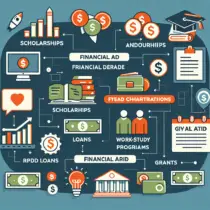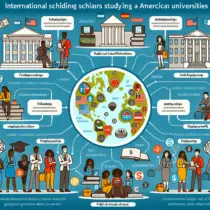Navigating the Scholarship Landscape: Essential Strategies for Success
Understanding the Scholarship Process
Applying for scholarships can often feel like navigating a complex maze. The journey can be quite daunting with numerous options, varying eligibility criteria, and stringent deadlines. However, having a well-planned strategy can significantly enhance your chances of securing a scholarship. This article offers essential strategies for success.
One fundamental aspect of navigating the scholarship landscape effectively is understanding the different types of scholarships available. Some scholarships focus on academic excellence, while others may cater to specific talents, community service, or financial need. Additionally, many scholarships are targeted at certain demographics or geographic regions.
Start Early and Stay Organized
Initiating the scholarship search early can provide a significant advantage. Early birds have the opportunity to explore a wide range of scholarships without the pressure of impending deadlines. Starting early also allows time to gather necessary documents, write and revise essays, and seek letters of recommendation.
Organization is another critical factor in successful scholarship applications. Keeping track of deadlines, required documents, and submission guidelines can prevent last-minute hassles. Utilizing tools like spreadsheets or dedicated apps can aid in staying organized.
Research Extensively
Thorough research is key to uncovering scholarships that match your profile. Many students miss out on valuable opportunities simply because they are unaware of them. Dedicated scholarship search websites and platforms can simplify this process. These platforms allow students to filter options based on their criteria and alert them to new opportunities.
For instance, students interested in studying in Australia might explore options like the "$5,000 Australia Global Alumni Engagement Mini-Grants in Australia, 2024." This particular scholarship focuses on fostering global alumni engagement and offers substantial financial support for successful applicants.
Understand Eligibility Requirements
Each scholarship has its own set of eligibility criteria. Understanding these requirements is crucial before applying. Applying for scholarships for which you are not eligible wastes time and effort.
Eligibility can be based on academic achievements, extracurricular activities, leadership roles, community service, or even the applicant’s field of study. Some scholarships also consider financial need as a primary criterion. Knowing what the scholarship committee is looking for will help tailor your application to meet their expectations.
Crafting Outstanding Applications
When it comes to scholarship applications, the quality of the application can make all the difference. Paying attention to every aspect of the application, from personal details to essays, is crucial.
Essays are often a significant component of scholarship applications. They provide an opportunity to showcase your personality, achievements, and aspirations. Craft compelling and personal essays that reflect your unique story. Remember to keep the essay focused, clear, and free of grammatical errors.
Letters of recommendation can also impact your application. Choose recommenders who know you well and can speak positively about your abilities and character. Providing them with ample time to write the letter and offering them information about the scholarship can result in stronger endorsements.
Maximizing Opportunities
One key strategy in the scholarship application process is to apply for as many scholarships as possible. Diversifying your applications across various types and sources increases the chances of success.
However, it’s also essential to be realistic and selective. Focus on scholarships that best match your qualifications and interests. For instance, students from Grenada might benefit from opportunities tailored specifically to them, such as the "Grenada Scholarships" program. Such regional or country-specific scholarships often have fewer applicants, increasing the chances of receiving the award.
Financial Planning and Scholarships
While scholarships can provide significant financial relief, they are just one component of funding a college education. It is beneficial to have a comprehensive financial plan that includes scholarships, grants, personal savings, and, if necessary, student loans.
Understanding the total cost of education, including tuition, books, accommodation, and other expenses, is crucial. Some scholarships may only cover part of these costs, making additional funding sources necessary.
Leveraging Campus Resources
Many institutions offer resources to help students navigate the scholarship landscape. Financial aid offices, academic advisors, and career counselors can provide valuable guidance and information. They can also alert students to institution-specific scholarships and grants.
Additionally, students should take advantage of writing centers for assistance with application essays and interview preparation resources to enhance their application skills.
Networking and Alumni Connections
Networking can play a vital role in discovering scholarship opportunities. Engaging with alumni, attending college fairs, and participating in community events can open doors to exclusive scholarships and grants.
For instance, scholarship opportunities like the "$5,000 Australia Global Alumni Engagement Mini-Grants in Australia, 2024," often arise from strong alumni networks. Staying connected with alumni and engaging in their activities can provide insights into such scholarships.
Scholarship Interviews
Some scholarships require interviews as part of the application process. Preparing thoroughly for these interviews is essential. Research common questions, practice with mock interviews, and dress appropriately for the occasion. Confidence and clear communication can significantly enhance your chances of success.
Dealing with Rejections
Rejections are an inevitable part of the scholarship application process. Do not be discouraged by them. Instead, use them as learning experiences. Analyze what might have gone wrong and seek feedback if possible.
Persistence is key. Continue applying for other scholarships, refining your applications based on feedback, and maintaining a positive attitude. Every rejection brings you closer to an acceptance.
Renewable Scholarships and Maintaining Eligibility
Securing a scholarship is fantastic, but maintaining it can be challenging. Many scholarships are renewable, provided that certain conditions are met. This could include maintaining a specific GPA, completing a certain number of credits, or engaging in community service or extracurricular activities.
Understanding and fulfilling these requirements is crucial to ensure continued financial support. Staying in regular contact with the scholarship provider and seeking assistance if you face academic challenges can help in maintaining your scholarship.
Global Opportunities
Exploring scholarships on a global scale can unveil more opportunities. Many countries offer scholarships for international students as part of their educational and cultural exchange programs. These scholarships can cover a wide range of expenses, including tuition, living costs, and travel.
For example, the "$5,000 Australia Global Alumni Engagement Mini-Grants in Australia, 2024" is a global scholarship aimed at fostering international connections and alumni engagement. Similarly, regional scholarships like the "Grenada Scholarships" provide specific opportunities for students from Grenada to pursue their educational goals.
Final Thoughts
Navigating the scholarship landscape requires a blend of strategic planning, thorough research, organization, and perseverance. Every student’s journey is unique, but the core strategies remain the same. Starting early, understanding eligibility, crafting strong applications, and staying organized will set the foundation for success.
Moreover, leveraging resources, networking, and maintaining a positive attitude can significantly enhance the chances of winning scholarships. By following these essential strategies, students can effectively navigate the complex scholarship landscape and achieve their academic aspirations with financial support.






